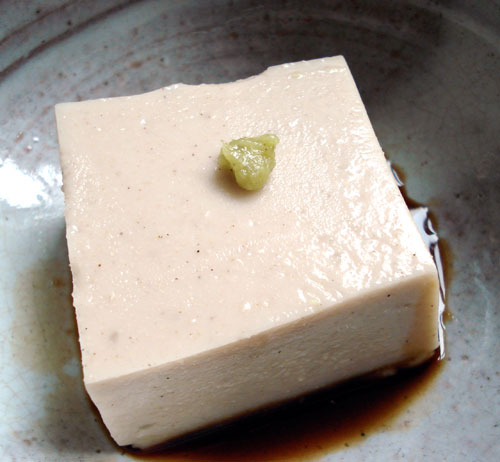
There are some dishes in Japan that look and have a texture like tofu, but are not tofu in the traditional sense; that is, they're not made from coagulated soy milk. One of these not-tofu tofus is goma dofu (ごま豆腐)or sesame tofu. Goma dofu is made from three simple ingredients: ground sesame paste, water, and kuzu or kudzu powder.
Filed under:
japanese vegetarian vegan gluten-free
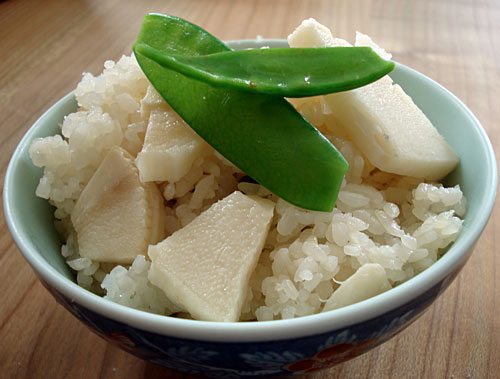
There are two Japanese vegetables that I can't get fresh here that I miss very much. One is burdock root or gobo; the other is bamboo shoot or takenoko (竹の子 or 筍). Bamboo shoots are very much a spring-only vegetable, much like asparagus, so around this time of year I always get a craving for the crunch and subtle flavor.
Filed under:
japanese vegetables spring rice vegan produce
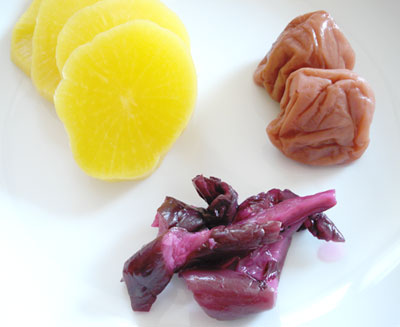
Periodically, someone asks about Japanese pickles - those crunchy, salty, sweet-sour, even spicy bits of goodness that accompany a traditional meal, especially breakfast. There are a big variety of Japanese pickles, and sooner or later you might consider making them.
Some time ago I did a week-long series on making instant, or overnight pickles. These pickles can be made very quickly, usually with ingredients that are easy to get a hold of. If you want to try your hand at Japanese style pickles, I recommend starting there. There are also a couple of cookbooks in English dedicated to quick and easy pickles, both of which are quite good: Quick and Easy Tsukemono: Japanese Pickling Recipes by Ikuko Hisamatsu, and Easy Japanese Pickling in Five Minutes to One Day: 101 Full-Color Recipes for Authentic Tsukemono by Seiko Ogawa.
However, the type of pickles that you are likely to be served in a high class traditional inn in Japan, or even the type you can buy in vacuum sealed packs at a supermarket, are a bit more complicated to make, especially outside of Japan. Here are some examples.
Filed under:
japanese vegetables vegan tsukemono pickles
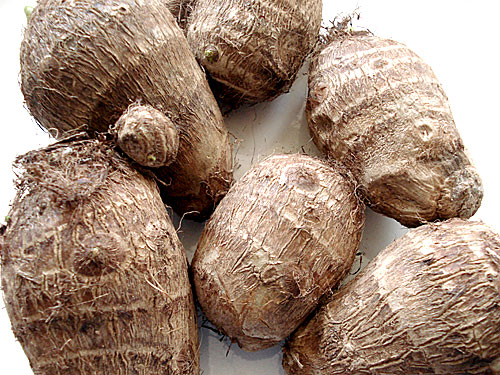
How to prepare that hairy looking beast, the taro root or satoimo.
Filed under:
basics japanese vegetables vegan
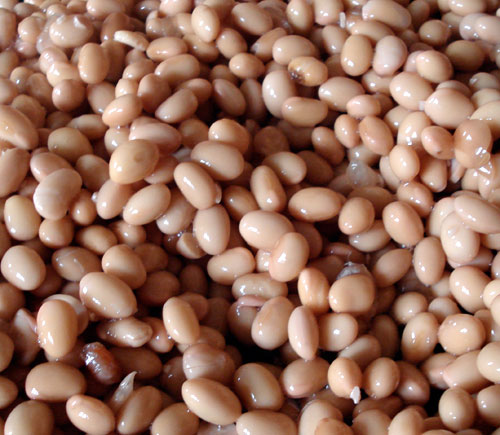
Until fairly recently I had a blind spot when it came to the humble soybean. I regularly consume soy products like soy milk, tofu and okara, not to mention fermented soybean products like natto and tempeh. And green soybeans or edamame are always a great snack.
But for some reason, I didn't really get into eating the whole dried (and cooked) soybean. It's not that they are that much harder to cook than other dried beans either.
In any case, I've rectified that situation and now I cook up a batch of soybeans quite regularly and store them in the freezer. Plain boiled soybeans are amazingly delicious, and just packed with nutrition. The cooking liquid is so rich that it can be used as a very nutritious stock or dashi for making soups and such.
There are a couple of points to watch out for when cooking whole soybeans, which are noted below in copious detail.
Filed under:
basics japanese ingredients legumes vegan
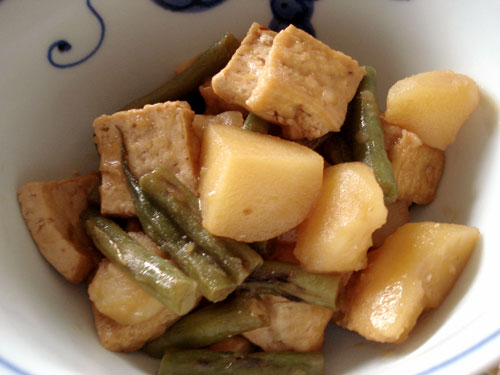
_Nikujaga_, stewed potatoes with meat, is a staple of Japanese home cooking. It's filling and comforting, and appears quite frequently for dinner at our house. Recently though I've been making this vegan version more frequently, which is just as tasty as the meaty version. Thick fried tofu (atsuage) is the protein replacement, but it's not just there for it's nutritional benefits - I love the texture in a lot of dishes.
The recipe, plus some ideas on how to reform Japanese non-vegan recipes to make them vegan, after the jump.
Filed under:
japanese potatoes vegetarian favorites vegan
More and more these days I'm getting requests for vegan and vegetarian recipes. While I'm not a vegetarian as I've stated here before, I like to eat a daily menu that's light on meat, and am always interested in vegan and vegetarian protein options.
There are several what I'd call factory-manufactured vegan protein products out there, from TVP to quorn. I'm sure they are safe and wholesome to eat, but I'm more interested in traditional, or time-tested, vegan/vegetarian protein alternatives.
This is the list I've come up with so far. They are Japanese-centric, since that's what I'm most familiar with. Do you have any others to add?
Filed under:
japanese ingredients vegetarian vegan
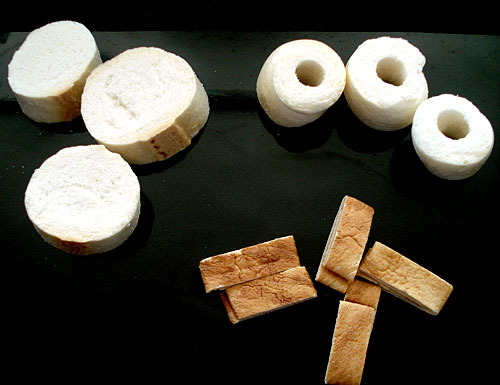
Vegetarians are probably familiar with seitan as a meat substitute. Seitan is wheat gluten that has been kneaded in such a way that the gluten threads align themselves to resemble meat. It was invented by advocates of the macrobiotic food movement in Japan, specifically as a meat substitute, in the 1960s. (Fairly accurate (from what I've read elsewhere) Wikipedia entry.)
But way before there was a macrobiotic movement, let alone seitan, people in Japan were already eating a wheat protein product called fu (麩). Like seitan, fu is made from the gluten that is extracted from wheat flour. Sometimes the gluten is mixed with other ingredients. There are two kinds of fu: raw (namafu 生麩), which is basically fresh fu; and grilled and dried (yakifu or yakibu 焼き麩). Here I'd like to focus on the dried kind which is much easier to get a hold of for people outside of Japan. It's also a great pantry item, since it keeps for a long time.
Filed under:
japanese ingredients vegetarian vegan
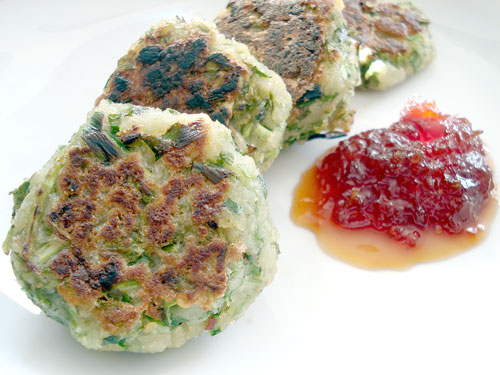
These tasty little savory cakes are made of ground lotus root. The texture is quite surprising - almost like mochi cakes. It's a great vegan, gluten-free savory snack that's high in fiber and packed with flavor.
Filed under:
party food vegetables vegetarian vegan gluten-free asian
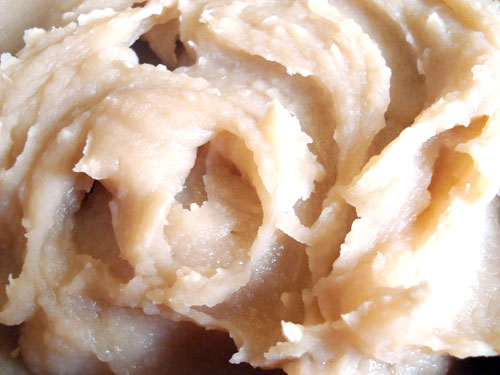
Usually when I put a recipe up here, it's something that's been fully resolved: that is, I've tried it out for myself (in most cases several times over), and I know that it works. This one is a bit different, but I thought I'd write about it in-progress, as it were, anyway.
Filed under:
legumes vegetarian vegan
Pages